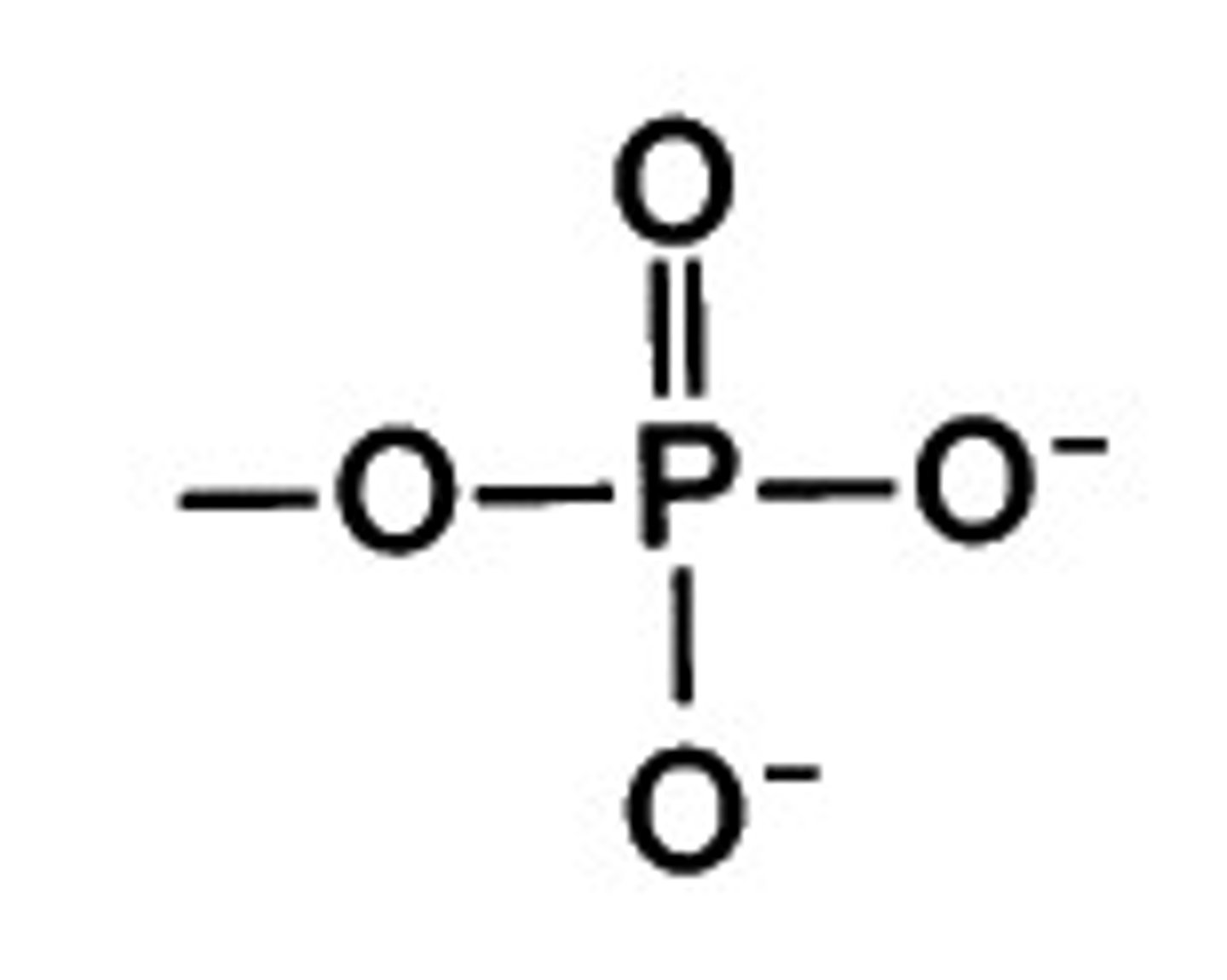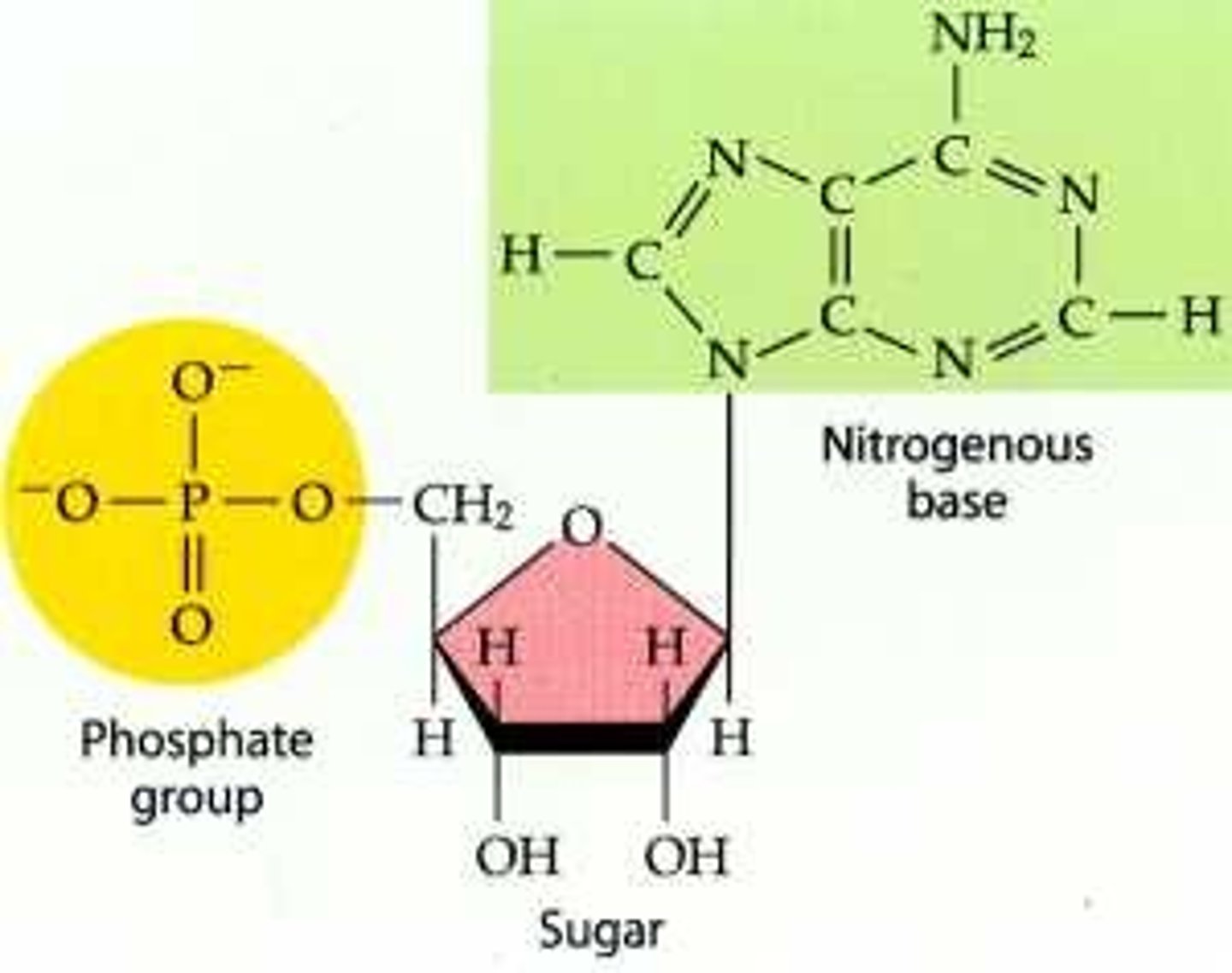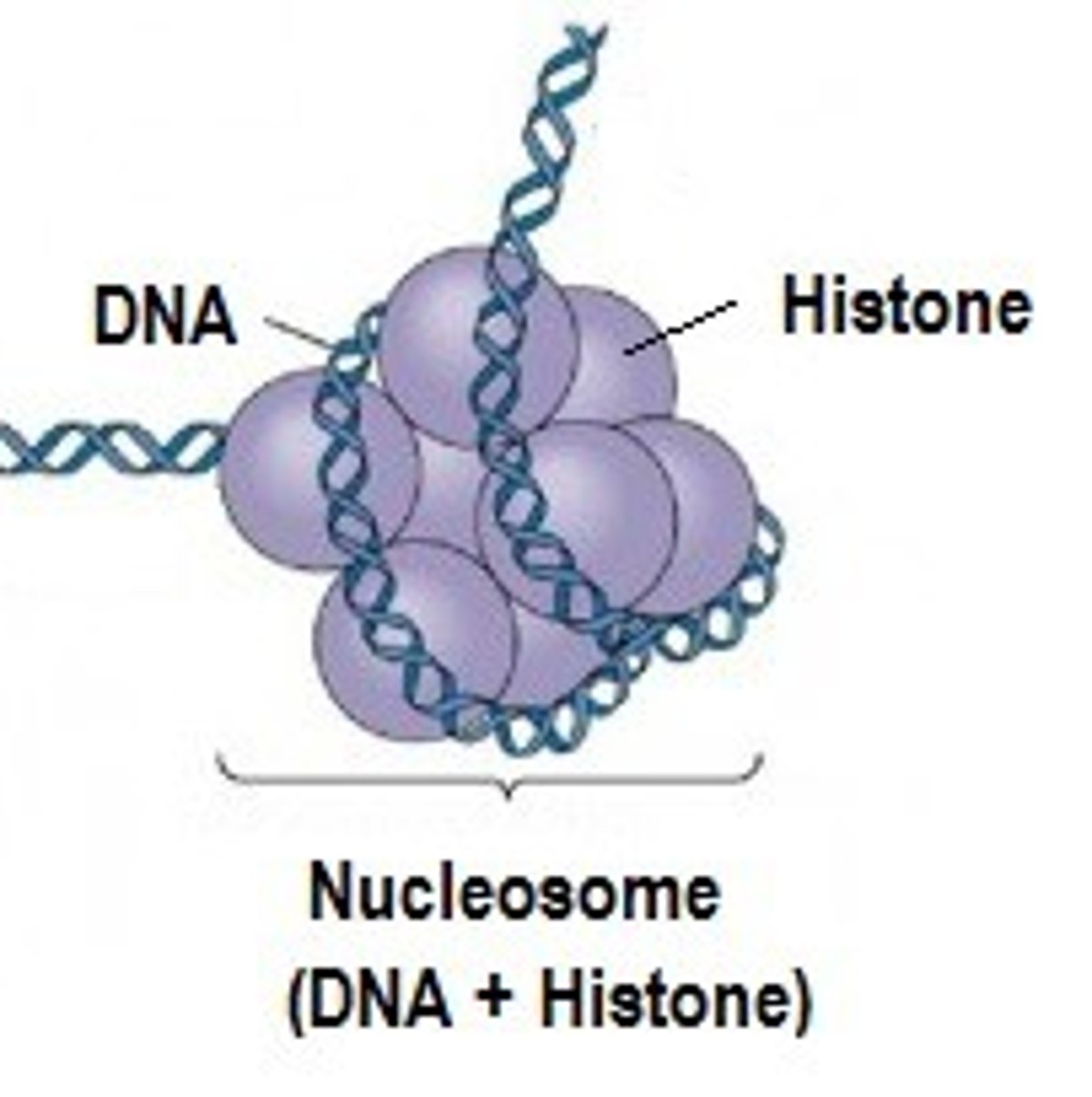BIOL 101 Chapter #9 Notes
1/74
There's no tags or description
Looks like no tags are added yet.
Name | Mastery | Learn | Test | Matching | Spaced |
|---|
No study sessions yet.
75 Terms
what are the two types of nucleic acids?
deoxyribonucleic acid (DNA) and ribonucleic acid (RNA)
what are the three parts of a DNA nucleotide?
deoxyribose (5-carbon sugar), phosphate group, and a nitrogenous base
what's the phosphate group?
a molecular group consisting of a central phosphorous atom bound to four oxygen atoms

what's the nitrogenous base?
nitrogen containing molecule that acts as a base

what are the four types of nitrogenous bases? (DNA)
Adenine (A), Thymine (T), Guanine (G), Cytosine (C)
are adenine and guanine purines or pyrimidines?
they're double-ringed purines
is cytosine and guanine purines or pyrimidines?
they're small single-ringed pyrimidines
carbon atoms of the five-carbon sugar are numbered as?
1' (one prime), 2' (two prime etc...), 3' , 4' , 5'
what is a double helix (In DNA)?
the molecular shape of DNA in which two strands of nucleotides wind around each other in a spiral shape
- structure is proposed by Francis Crick & James Watson
- originally found by Rosalind Franklin though*
what is Chargaff's rule?
A pairs with T, G pairs with C
- equal amounts of both base pairs
how is adenine and thymine connected by?
how is cytosine and guanine connected by?
- connected by two hydrogen bonds
- connected by three hydrogen bonds
what is the direction of the DNA strands?
they are anti-parallel (going opposite directions) with 3' carbon going upward position (always the arrow) and a 5' carbon at an upward position
what's the structure of RNA?
single strand of nucleotides, consisting of a nitrogenous base, five-carbon sugar, and a phosphate group
- five-carbon sugar is called ribose
- ribose has a hydroxyl group at 2' carbon

RNA contains what? what doesn't it have?
contains nitrogenous bases Adenine (A), Cytosine (C), Guanine (G), and Uracil (U); it does NOT contain Thymine (T)
In RNA, what is Thymine replaced with?
with Uracil (U)
- new base pair is (AU)
what are the three types of RNA mentioned in the chapter?
messenger RNA (mRNA), transfer RNA (tRNA), and ribosomal RNA (rRNA)
- all majorly involved in the production of proteins
what do most prokaryotes contain (chromosome related)?
a single, circular chromosome that is found in an area in the cytoplasm (nucleoid)
how does DNA contain all these millions of base pair combos?
through super coiling
- special proteins & enzymes help maintain the structure
what are histones?
the protein that DNA is wrapped around
- imagine DNA as a string and the histones as beads on the string

what are metaphase chromosomes?
during cell division, chromosomes are at their most compacted state, held together by scaffold proteins
what is semi-conservative in DNA replication?
each DNA strand of the double helix is used as a template strand for the synthesis of two new strands
- results in DNA composed of one new and one old strand
what is DNA polymerase?
an enzyme that joins individual nucleotides to produce a new strand of DNA by adding complementary base pairs to DNA strands
- can only add to the 3' strand
what is the replication fork?
a Y-shaped region where the parental strands of DNA are being unwound
what is RNA primer?
a short segment of RNA, normally about 10 nucleotides long, required to start a new chain
- adds nitrogenous bases A, U, G, C to DNA strand
- later sealed by DNA ligase
what happens on the leading strand in DNA replication (5' to 3')
DNA polymerase builds to the replication fork
- synthesized continuously in the 5' to 3' direction
what happens on the lagging strand
DNA polymerase builds away from direction of replication fork; the DNA segments left behind are called Okazaki Fragments
- synthesized discontinuously (segments) in the 3' to 5' direction
what is the telomerase?
enzyme that has a built-in sequence of DNA/RNA that goes at the end of a DNA strand (3' to 5' strand) to add pairs to 5' to 3' strand
- eukaryotes have this; prokaryotes DO NOT
- founded by Elizabeth Blackburn
what is a telomere?
the DNA sequence at the end of linear chromosomes
- repetitive sequence that doesn't code for any specific gene
what is a helicase?
an enzyme that helps open up (unzips) DNA double helix during DNA replication by breaking hydrogen bonds
what is primer (RNA)?
a short stretch of RNA nucleotides that are required to initiate replication and allow the binding of DNA polymerase
- gives complementary bases to a DNA parental strand
what is DNA ligase?
an enzyme that catalyzes the joining/formation of DNA fragments together
what is the process of DNA replication summarized? (three steps)
I. DNA unwinds at origin of replication
II. new nitrogenous bases are added to the complementary parental strands; one strand continues, and the other strand lags
III. Primers (RNA) are removed, new DNA nucleotides replace primers and spaced-segments are sealed by DNA ligase
what is mismatch repair?
the form of DNA repair where non-complementary nucleotides are recognized, excised(removed), and replaced with the right complementary bases
what is nucleotide excision repair?
DNA repair process, where the damaged section of DNA is removed and replaced with nucleotides using the complementary strand 5' to 3'
- incorrect bases are removed!
what is a mutation?
a permanent change in the DNA sequence of a genome (nucleotide/gene wtv)
what is polymerase mistakes?
1 error made in nucleotides every 100,000 nucleotides (10 to 5), but an enzyme later fixes most mistakes, so the final error is 1 error per 10 million nucleotides (10 to 10)
what are some of the causes of DNA sequence mutations?
radiation (UV damage), replication, and chemicals
does mutation help with evolution, how?
yes; mutations drive natural selection
- most will be harmful; small amounts of mutation are beneficial
what is the central dogma?
- DNA encodes RNA (transcription process)
- RNA encodes Protein (translation process
what's the overall function of the central dogma?
gene expression; it takes one gene and expresses it into a protein
what is mRNA?
messenger RNA; it's a form of RNA that carries the nucleotide sequence code for a protein sequence that is later translated into a polypeptide sequence (central dogma function)
what is transcription?
DNA to mRNA
- occurs in the nucleus of a cell & mRNA must be transported to the cytoplasm (occurs in only eukaryotes)
- for prokaryotes, this occurs in the cytoplasm of a cell
what are the three stages of transcription?
initiation, elongation, and termination
what is initiation?
DNA double helix partially unwinds in the region of mRNA synthesis
what is the transcription bubble? (sub-set of iniation)
the region of unwinding on the mRNA, allowing transcription to occur
what is the promoter? (sub-set of iniation)
a sequence on DNA where RNA polymerase and its associated factors (proteins and enzymes) bind to & initiate transcription
- it determines whether a corresponding gene is transcribed all the time, some of the time, or hardly at all
what is elongation?
the addition of nucleotides to the new DNA strand
what are the factors in elongation?
the template strand, non-template strand, and RNA polymerase
what is the non-template strand?
strand of DNA that is not used to transcribe mRNA; this strand is identical to the mRNA except for the nitrogenous base T which is replaced by nitrogenous base U in mRNA
what is the template strand?
strand of DNA that specifies the complementary mRNA molecule
what is RNA polymerase?
an enzyme that synthesizes (combines), an RNA strand from a DNA template strand
what is termination?
stops transcription, (prokaryotic) soon as the mRNA is made, ribosomes start making proteins
- eukaryotic cells processes of transcription and translation occur at different times
what are eukaryotic genes composed of?
exons and introns
what are exons?
the segments of a gene that remain in the mRNA after the pre-mRNA has been spliced. They contain the coding sequences that are translated into proteins. Essentially, exons are the parts of the gene that "exit" the nucleus and are expressed as proteins
what are introns?
non-protein coding intervening sequences that are spliced from mRNA during processing
what is splicing?
the process of removing introns & reconnecting exons in pre-mRNA
what is pre-mRNA? (not in notes)
the initial, unprocessed RNA transcript of a gene, containing both coding regions (exons) and non-coding regions (introns)
what is the promoter? (video notes**)
controls the rate of transcription
what is elongation? (video notes**)
RNA polymerase opens up gene, and adds its nucleotides (A, U, C, G)
what is alternative splicing?
a gene regulation mechanism in eukaryotes that allow different protein products to be produced from one gene when different combinations of introns (sometimes exons) are removed from the transcript
- allows for many diverse genes
what is the Poly-A tail?
a sequence approximate 200 adenine nucleotides added onto the 3' end of a pre-mRNA molecule
what are ribosomes?
part of rRNA, has stabilizing proteins
- made up of small sub-unit & large sub-unit
what is the small sub-unit?
binds the mRNA (only holds onto mRNA)`
what is the large sub-unit?
binds tRNA
what is tRNA?
transfer/translation RNA, a form of RNA that reads mRNA codon and brings the appropriate amino acid
- translates language of RNA into the language of proteins
what are codons?
sequence of three mRNA nucleotides which together form a unit of genetic code in a DNA or RNA molecule
what is the genetic code?
the amino acids that correspond to three-nucleotide codons of mRNA
- is universal; can be applied to every living organism
what are stop codons?
one of the three mRNA codons that specifies termination of translation
- UAA, UAG, UGA
what are start codons?
the AUG (rarely GUG) on an mRNA from which translation begins; always specific for methionine
- initiates translation
what is gene expression?
the process of turning on a gene to produce RNA and protein
what is an operon?
a cluster of genes that are transcribed together
what's a lac operon? (prokaryotic gene expression ex.)
enzymes that break down lactose
what happens if there is no lactose present for the lac operon? (prokaryotic gene expression ex.)
repressor binds to operator, turning off the enzymes that break down the lactose
what happens if there is lactose present? (prokaryotic gene expression ex.)
lactose binds to a repressor, and opens up the operator (Make Mo Enzymes!!)
what is epigenetic?
describes non-genetic regulatory factors
- describes changes in DNA that control access to genes in chromosomes